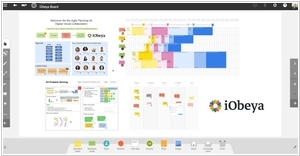JIRA vs iObeya
March 15, 2025 | Author: Adam Levine
82★
JIRA provides issue tracking and project tracking for software development teams to improve code quality and the speed of development. Combining a clean, fast interface for capturing and organising issues with customisable workflows, OpenSocial dashboards and a pluggable integration framework, JIRA is the perfect fit at the centre of your development team.
6★
iObeya digitizes the obeya experience, providing an easy, powerful and secure way to connect Lean & Agile Teams of Teams in the new work environment. Discover a place where teams come together to manage operations, solve problems, brainstorm ideas and continuously improve.
See also:
Top 10 Visual Collaboration software
Top 10 Visual Collaboration software
JIRA and iObeya, despite sounding like alien species from a long-forgotten Hitchhiker’s Guide appendix, are actually tools designed to make humans feel marginally less lost in their own projects. Both claim to bring order to chaos, offering Agile methodologies, workflow visualization and integrations with other software, because, let’s face it, no one tool is ever enough. Enterprises love them because they promise teamwork, visibility and a vague sense of productivity while simultaneously ensuring that nobody ever truly understands where a project begins or ends.
JIRA, born in the distant land of Australia in 2002, was created for software developers who, left to their own devices, would happily live in darkened rooms muttering about bugs and sprints. It offers automation, backlog grooming and an almost infinite ability to customize workflows—though most users will never quite agree on the best way to do so. It thrives on tickets, epics and a constant stream of updates that leave teams wondering if they are making progress or just documenting their own suffering in real-time.
Meanwhile, in France, iObeya emerged in 2011, not to track bugs, but to digitize the sacred whiteboards of Lean management enthusiasts. Instead of tickets, it offers virtual walls, post-its and the illusion of an infinitely stretchable office space without the need for additional furniture. While JIRA delights software developers, iObeya caters to executives, manufacturing teams and strategy wizards who prefer their Agile frameworks served with a touch of high-level visualization rather than an endless backlog of unresolved issues.
See also: Top 10 Visual Collaboration software
JIRA, born in the distant land of Australia in 2002, was created for software developers who, left to their own devices, would happily live in darkened rooms muttering about bugs and sprints. It offers automation, backlog grooming and an almost infinite ability to customize workflows—though most users will never quite agree on the best way to do so. It thrives on tickets, epics and a constant stream of updates that leave teams wondering if they are making progress or just documenting their own suffering in real-time.
Meanwhile, in France, iObeya emerged in 2011, not to track bugs, but to digitize the sacred whiteboards of Lean management enthusiasts. Instead of tickets, it offers virtual walls, post-its and the illusion of an infinitely stretchable office space without the need for additional furniture. While JIRA delights software developers, iObeya caters to executives, manufacturing teams and strategy wizards who prefer their Agile frameworks served with a touch of high-level visualization rather than an endless backlog of unresolved issues.
See also: Top 10 Visual Collaboration software





